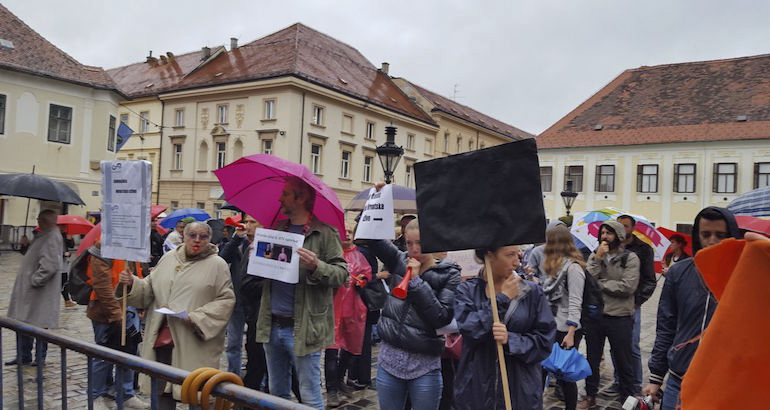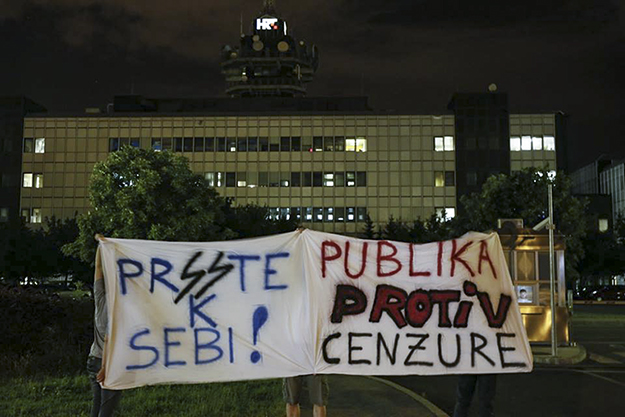Attacks on journalists, hate speech in the public arena, imposed censorship and political pressure on the public broadcasting service — this is a summary of the worrisome situation in Croatian media.
In the past few years, Croatia has fallen down the rankings of media freedom; according to Reporters Without Borders (RSF), Croatia has dropped from 63rd place to 74th. What is more concerning is the lack of public reaction to attacks on Croatian journalists. The government itself is attempting to control the work of the public broadcasting service.
Saša Leković, chairman of the Croatian Journalists’ Society, says that his organization has registered numerous threats received by journalists, from serious verbal to death threats, to physical assaults. The biggest problem for Leković, is that in most cases, the perpetrators are not punished adequately.
Threats received by the media intensified after the ruling against six Croats from Bosnia and Herzegovina and the suicide of general Slobodan Praljak in the Hague Tribunal on November 29, 2017. Nataša Božić, a journalist from the Croatian N1 program, received death threats because she asked questions regarding the removal of medals and ranks from soldiers who committed war crimes.
Death threats were reported by numerous journalists who wrote about war crimes convictions for Praljak and others. Along with this, right wing associations have succeeded in removing Facebook pages of left wing groups by sending complaints to the social media giant. Facebook responded by stopping Croatian left wing portals such as Lupiga, Antifa Zagreb, and the Antifašistički vjesnik.
Harlem Desir, a Organization for Security and Co-operation in Europe (OSCE) representative, called upon the Croatian government to investigate death threats sent to journalists, and to take their safety into consideration.

Civic society actors have demanded more freedom of speech and protests against censorship. Photo: Jelena Prtorić.
The hysteria that ensued after the ruling against General Praljak is only a culmination of the current trend of censorship, polarization and proliferation of nationalist narratives in Croatian media.
“In most cases, the perpetrators are not discovered, unless a person doesn’t try to hide her or his identity,” Leković explains.
“The police discovered the perpetrators in this instance, because it isn’t an issue to do so. In cases where particular IPs are generated or an anonymous letter is sent containing no fingerprints, nothing can be done in such cases. Even when these cases are solved, its with conditional sentences, meaning that nobody actually ends up in jail.”
“Haters of All Things Croatian” vs. Patriotic Broadcasting Service
Threats to journalists and conflicts, in both the public sphere and personal level, are only part of a bigger picture of media freedoms in Croatia. Having fallen 11 places in the annual Reporters Without Borders rankings, EU member Croatia is now considered worse off in terms of media freedoms than regional neighbors Slovenia, Bosnia and Herzegovina and Serbia.
Regional press freedoms
Every year Reporters Without Borders produces a World Press Freedom Index, observing the state of the media in 180 countries worldwide. Countries with lower numbers have the greatest freedom of speech, with Norway currently holding the number 1 spot.
37. Slovenia
65. Bosnia and Herzegovina
66. Serbia
74. Croatia
76. Albania
82. Kosovo
106. Montenegro
111. Macedonia
(Rankings relate to the latest data, from 2017)
A 2017 RSF report about government interference in public broadcasting said that the Croatian government was meddling in public media work, and that “Journalists investigating corruption, organized crime, or war crimes are often subjected to harassment campaigns.” The report mentioned that defamation has been criminalized in Croatia, and that insulting the Republic, its symbols, anthem, or flag is punishable by up to three years in jail.
This trend in restricting freedom of the media may be tracked back to 2014, through to the end of 2015, when the so-called Patriotic Coalition came to power. This included the right wing Croatian Democratic Union (HDZ) party under the leadership of Tomislav Karamarko and the then newly formed right wing party Bridge of Independent Lists (Most).
Leković suggests that the tone Karamarko established in terms of freedom of the press was, “Everybody in their homes, within their four walls, may speak and think what they wish, but not publicly.”
The appointment of Zlatko Hasanbegović as minister of culture in 2016, was also significant as part of the rule of the Patriotic Coalition; since then, his name has become synonymous with the degradation of media freedoms. This is in spite of the fact that his ministerial position includes responsibilities in the field of media.
The first move by the newly appointed minister was the abolition of support provided to non-profit media. This includes organizations who are not financed by advertisers or the public broadcasting service. Non-profit media tend to deal with issues rarely discussed in the mainstream media. Around this time, the Croatian Society of Journalists and Publicists (HNIP) was established by right wing journalists, many with close political links, a move that Leković believes was politically motivated with the primary political aim of controlling the media.
Soon after, the settling of scores with the public broadcasting service, Croatian Radiotelevision (HRT) ensued. Some 70 journalists or editors were demoted or displaced as part of this ideologically motivated purge.
The media purge continued to the very end of the rule of the Patriotic Coalition. Its collapse in 2016, following a corruption scandal that incriminated the then vice president of the government and HDZ president, Tomislav Karamarko, and his wife, caused a split between already unstable coalition partners and meant the administration ended with the shortest tenure in Croatia’s history.
At the very end of the government’s rule, the administration began to exert pressure on HRT3 (Channel 3 of the Croatian Broadcasting Service); even though it had long been hailed for its “not meant for everyone” content, it simultaneously represented the last bastion (of non-mainstream) media culture. This was a space where it was possible to listen to and watch opera, theater discussions, chess games, and radio documentaries.

Croatia’s third public broadcasting channel HRT3 was under attack from the government, but defended by citizens and journalists. Photo: Anja Mergeduš.
However, HRT3 was not the only institution that began to feel the weight of increasing government interference in the media.
After the termination of the “Dobro jutro: kultura” show on HRT3, the public broadcaster’s third radio station, HR3, lost the “Jutro na trećem” show — which hosted artists, cultural actors and scientists — overnight. Two other radio shows, “Audiodoc” and “Skrivena strana dana,” the last in Croatia to produce and broadcast radio documentaries, were discontinued at the same time. The station’s autumn schedule replaced them with new content dedicated to Christian spirituality and “religious and scientific content,” edited by authors much closer to the then-government.
In July 2016, a citizens’ initiative called “Freedom to the Thirds” (“Sloboda Trećima”) organized a protest. This initiative was more than symbolic as it established a radio show with guests coming on stage demanding that the public broadcasting service remain what it was, while making room for the abolished shows in the autumn schedule.
These demands remained unanswered, while in the following months religious programming on television continued to grow. “Every week in August across all four television channels, on average four religious documentaries, repetitions of most of the standard religious shows, two masses, and two shows from the Catholic heritage were broadcast,” wrote the Novosti weekly as part of its September 2016 analysis titled Requiem for HRT.
Different approach, same results
Autumn 2016 brought Croatia new snap parliamentary elections. HDZ came to power once again, in a coalition with Most for the second time. Even though this was a more moderate current of HDZ, and the new prime minister Andrej Plenković was presented as the more liberal side of HDZ who wanted to get this party back to the center right, the government policies toward the media have changed little.
With Plenković’s arrival, Zlatko Hasanbegović was removed from the seat of the minister of culture and replaced by Nina Obuljen Koržinek. Obuljen raised hopes that she would normalize Croatian media policies. However, more than one year into the current minister’s tenure, the abolished shows have not been brought back and there has been a fresh round of purges in the public broadcasting service.
The new contract signed in 2017 between the government and the public broadcasting service, clearly states that HRT has a duty to “protect the dignity and promote the values of the Homeland War.”
In September 2017, the show “Hrvatska uživo,” a show giving voice to minorities and vulnerable groups who have little access to the media, was abolished overnight. Simultaneously, the level of patriotic reporting increased. When Aleksandar Stankovic, a host of a popular weekly political show “Nedjeljom u dva” used the term “civil war” (instead of Homeland War), to refer to the ’90s conflict, he was instantly reprimanded by HRT management.
Also, the management threatened to sack radio host and journalist Milorad Šikanjić for alleged hate speech after he critiqued the leader of the Croatian People’s Party (HNS) for forming a coalition with right wing HDZ, having been an ally of the center left Social Democratic Party of Croatia (SDP) for years.
With the most recent moves toward patriotism, the comedy film “Ministry of Love” has been banned by the public broadcaster since the beginning of January following pressure from associations of Croatian defenders’ widows. The film is set against the background of responding to a financial crisis, with the government’s response being to start researching all cases in which wartime widows still receive pensions, even when living with new partners.
The new contract signed in 2017 between the government and the public broadcasting service, clearly states that HRT has a duty to “protect the dignity and promote the values of the Homeland War.”
An analysis by the Bilten web page, also notes that compared to the previous contract, the new contract more explicitly references “Croatian national values.” According to the new contract, HRT should also “promote measures of demographic, pro-natality, and family policies in its informative programs” in the future.

‘Keep your hands off. Public against censorship.’ Government interference in Croatia’s public broadcaster has been strongly criticized by both citizens and international media freedoms organizations. Photo: Jelena Prtorić.
Simultaneously, the position of the new minister towards non-profit media has not changed. No new grants have been reintroduced and the inflow of funding streams has been stopped. As much as 30 million Croatian kuna (4 million euros), which has been withdrawn from European funds for the purpose of financing the “media community,” has still not been awarded to the only media sector that could qualify for those funds.
At the same time, certain portals have sought refuge in individual benefactors in the form of crowdfunding. The Portal Forum broke ice in late 2016 with their first media crowdfunding campaign titled “Let Them See There Are Many of Us.” Within the first 24 hours more than the requested 5,000 donations were secured, while the same was achieved by the Lupiga portal in December, after managing to gather $20,000 (16,000 euros).
However, other organizations might be heading down the road of the Muf.hr portal, which was dedicated to feminist critique of pop culture. Four years on from its establishment, Muf.hr’s founders announced last month that they would stop working. Though financial means were not a decisive factor in the matter, they stated that “things could have been better if the Ministry of Culture hadn’t devastated the non-profit media sector in the last two years.”
Internationally reprimanded
Apart from financial issues, the latest assaults mentioned at the top of this article have been met with a lack of condemnation by the authorities. Last month an international delegation of press freedom representatives from a range of international media organizations visited Croatia and raised concerns about the stifling of media freedoms and increased pressures on journalists. It reported that “the government is not doing enough to prevent political pressure on the media and strongly condemn attacks on journalists.”
Croatia is the only member state of the European Union to have been visited by the delegation twice in less than two years, having also been visited in June 2016. Although this time it said that the situation was slightly better than in 2016, it also raised concerns about “biased reporting and internal structure of managing HRT,” and the fact that the public broadcasting service is exposed to political pressure and pressure by certain interest groups. It additionally noted that the devastating influence of hate speech had increased and that the public arena has become poisoned by verbal attacks, including those against journalists.
“Recently, the prime minister stated that journalists should not be attacked, but this statement has largely been seen as lip service,” Saša Leković says. “In Croatia, journalists are not defended against attacks or they are ignored outright. The government has not responded to any warnings about dealing with attacks on journalists, censorship, and pressure. This has led to self-censorship worsening problems relating to freedom of the media.”
Unlike in neighboring Serbia, where orchestrated attacks by government aligned tabloids are persistent, in Croatia the methods used by the government are different. But, “the end result is almost the same,” Leković believes, adding that it is reflected in the erosion of media freedoms and censorship, but also a general deterioration of the freedom of speech in the context of an ever-increasing number of conservative associations in the Croatian public arena, and the passive role of the government that does not condemn such behavior.
“In Croatia, there is now some sort of a clerical-nationalist cultural counter revolution… I don’t know what other words I could use to call it,” Leković said in a sharp tone. With a similar trend noticeable in other spheres in life, from education to culture, the indications are that the civil sector will soon face a real fight.K
Feature image: Majlinda Hoxha / K2.0.




